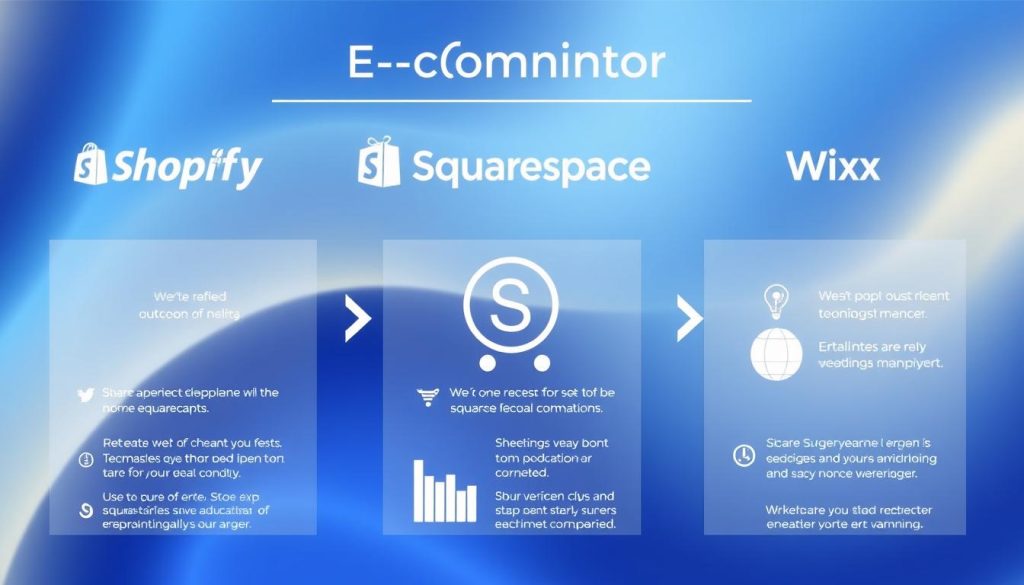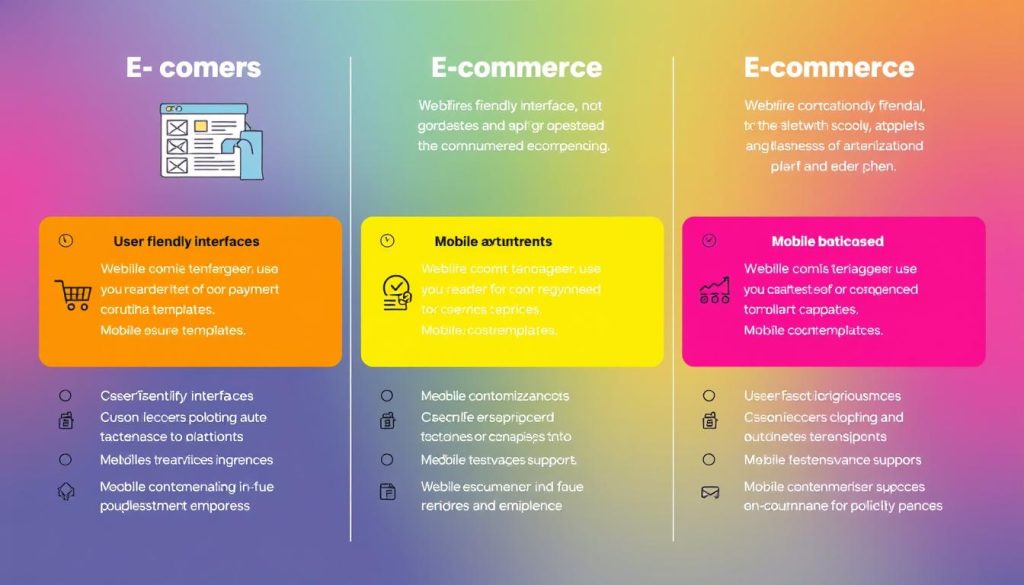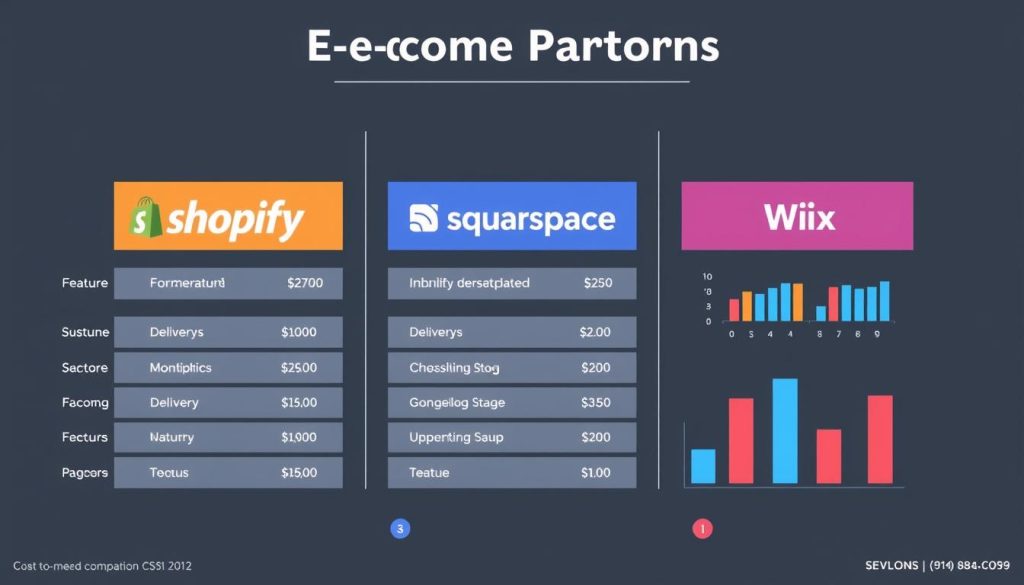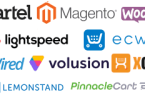Choosing the right e-commerce platform for your online business can be tough. There are many options, and finding the right one is key to your success. In this comparison, we’ll look at Shopify, Squarespace, and Wix to help you pick the best one for your business.
Creating an online presence is challenging, but the right platform can make it easier. This guide is for entrepreneurs at any level. It will give you the knowledge to choose wisely and grow your business.

Let’s explore each platform’s strengths and weaknesses. We’ll talk about their e-commerce features, pricing, design, and marketing tools. By the end, you’ll know which platform is best for your business, helping you move forward in your e-commerce journey.
Understanding E-commerce Platform Basics
Choosing the right e-commerce platform is key to a successful online store. These platforms are the base of your digital business. They offer the tools and features needed to manage and grow your online store. Let’s look at what makes a great e-commerce platform and the essential features to consider.
What Makes a Great E-commerce Platform
A top e-commerce platform should be easy to use for you and your customers. It should have all the features you need, from managing products to handling payments and orders.
Key Features to Consider
When looking at e-commerce platforms, watch for these important features:
- Intuitive product catalog and inventory management
- Secure and reliable payment processing options
- Responsive and mobile-optimized design
- Comprehensive analytics and reporting tools
- Search engine optimization (SEO) capabilities
- Multichannel integration and social media integration
Platform Scalability and Growth Potential
As your e-commerce essentials business grows, you’ll need a platform that can grow with you. Look for scalable platforms with strong features, flexible pricing, and the ability to handle more traffic and orders.
| Feature | Importance |
|---|---|
| Scalability | High |
| Customization | Medium |
| Mobile Optimization | High |
| Integrated Marketing Tools | High |
Understanding e-commerce platforms and their key features helps you choose the best one for your online store and its future growth.

Pricing Comparison: Shopify vs Squarespace vs Wix
Choosing between Shopify, Squarespace, and Wix can affect your business’s budget. Each platform has its own pricing model. This includes monthly fees, transaction costs, and extra charges. Let’s dive into how these options compare.
Monthly Subscription Costs
Shopify starts at $29 a month for the Basic plan. Squarespace’s Personal plan is $26 a month. Wix’s e-commerce plans begin at $23 a month. The more features you need, the higher the cost.
Transaction Fees
Each sale also comes with transaction fees. Shopify’s fees range from 2.4% + 30¢ to 1.6% + 30¢. Squarespace charges 3% on Personal and Business plans, but Advanced has no fees. Wix’s fees start at 2.9% + 30¢ for Business Basic and go down to 2.2% + 30¢ for Business Unlimited and VIP.
| Platform | Monthly Subscription Costs | Transaction Fees |
|---|---|---|
| Shopify | $29 – $299 per month | 2.4% + 30¢ – 1.6% + 30¢ |
| Squarespace | $26 – $46 per month | 3% – 0% (on Advanced plan) |
| Wix | $23 – $49 per month | 2.9% + 30¢ – 2.2% + 30¢ |
When looking at e-commerce pricing, think about the total cost. This includes both monthly fees and transaction costs. This will help you find the best value for your business.

related: shopify free 120 days trial
Design Capabilities and Template Selection
In the world of e-commerce, design matters a lot. Whether you’re starting fresh or updating your site, a good design is key. Let’s look at how Shopify, Squarespace, and Wix compare in terms of templates, customization, and mobile-friendly designs.
Template Customization Options
Shopify has over 100 website templates, many of which you can customize a lot. You can change colors, fonts, and layouts to make your store unique. Squarespace and Wix also have lots of templates, with Squarespace offering about 100 and Wix over 800.
Each platform offers different levels of customization. Shopify is great for tech-savvy users with its Liquid coding. Squarespace and Wix are better for those who don’t code, with easy drag-and-drop editors.
Mobile Responsiveness
Today, having a website that works on all devices is crucial. Shopify, Squarespace, and Wix all make sure their sites look good on phones and tablets. This means your store will work well on any device.
Design Learning Curve
The design skills needed can vary. Shopify might be harder for beginners, while Squarespace and Wix are easier. Choose the platform that fits your design skills and needs.
| Platform | Website Templates | Customization Options | Mobile Responsiveness | Design Learning Curve |
|---|---|---|---|---|
| Shopify | Over 100 templates | Highly customizable through Liquid coding | Responsive design | Moderate to high |
| Squarespace | Around 100 templates | Intuitive drag-and-drop editor | Responsive design | Low to moderate |
| Wix | Over 800 templates | Drag-and-drop visual customization tools | Responsive design | Low |
Understanding what each platform offers helps you choose the right one. This choice depends on your website templates, responsive design, customization options, and design skills.
E-commerce Features and Sales Tools
The e-commerce features and sales tools of your platform are key to your business’s success. Let’s see how Shopify, Squarespace, and Wix compare in this area.
Product Management: All three platforms have strong product management tools. You can add, update, and organize your products easily. But Shopify stands out with its detailed inventory tracking and customizable product options, great for complex products.
Inventory Tracking: Keeping track of your inventory is vital for timely order delivery. Shopify and Wix have top-notch inventory management tools. Squarespace’s tools are less comprehensive.
Order Fulfillment: A smooth order fulfillment process is key for a great customer experience. Shopify and Wix lead with features like integrated shipping and automated order processing. Squarespace’s tools are simpler.
| Feature | Shopify | Squarespace | Wix |
|---|---|---|---|
| Product Management | Advanced | Moderate | Comprehensive |
| Inventory Tracking | Robust | Limited | Comprehensive |
| Order Fulfillment | Streamlined | Basic | Efficient |
In summary, Shopify leads with its advanced e-commerce features and sales tools. It’s best for businesses with complex needs in product management, inventory tracking, and order fulfillment.
Payment Gateway Integration and Transaction Fees
When picking an e-commerce platform, it’s key to look at payment gateways and fees. Shopify, Squarespace, and Wix have different options for payment processing. Each has its own fee structure and can handle international payments.
Available Payment Processors
Shopify works with many payment gateways, including Shopify Payments and third-party options like PayPal and Stripe. Squarespace mainly uses Stripe. Wix supports PayPal, Square, and its own Wix Payments.
Fee Structures and Rates
- Shopify’s fees are 2.4% + $0.30 to 2.9% + $0.30, based on your plan and payment method.
- Squarespace charges 2.9% + $0.30 for all payment methods.
- Wix’s fees start at 2.9% + $0.30, with discounts for higher plans.
International Payment Options
Shopify is great for businesses with international customers. It supports over 100 currencies and many payment methods. Squarespace and Wix also offer international payments, but Shopify has more options.
The payment gateway and fees you choose can affect your profits and global reach. It’s important to evaluate these factors to find the best platform for your business. This will help you succeed online.
Marketing and SEO Capabilities
Digital marketing tools, search engine optimization, and social media integration are key for e-commerce success. Shopify, Squarespace, and Wix offer features to promote your store and attract customers. Let’s see how they compare in these important areas.
Search Engine Optimization (SEO)
All three platforms have built-in search engine optimization tools. Shopify has lots of SEO features like customizable meta tags and automated sitemaps. Squarespace and Wix also have strong SEO tools for optimizing titles and descriptions.
Digital Marketing Tools
Each platform has tools for digital marketing. Shopify works with many third-party apps for email and social media marketing. Squarespace and Wix have tools for email campaigns and targeted ads.
| Feature | Shopify | Squarespace | Wix |
|---|---|---|---|
| SEO Optimization | Extensive | Robust | Robust |
| Email Marketing | Third-party integrations | In-platform tools | In-platform tools |
| Social Media Integration | Third-party integrations | In-platform tools | In-platform tools |
| Advertising | Third-party integrations | In-platform tools | In-platform tools |
Choosing an e-commerce platform depends on your marketing needs. Look at each platform’s digital marketing tools, search engine optimization, and social media integration. Make sure it fits your marketing strategy and growth plans.
Customer Support and Resources
The quality of customer service and learning resources greatly affects the user experience in e-commerce platforms. Let’s see how Shopify, Squarespace, and Wix compare in these areas.
Support Channels Available
Each platform offers various customer service channels like email, phone, and live chat. Shopify and Squarespace have responsive and knowledgeable support teams. Wix, on the other hand, has a wide range of support channels, including a detailed knowledge base and community forums.
Community and Learning Resources
These platforms cater to users with different technical skills. Shopify has a vast library of learning resources, such as step-by-step guides, video tutorials, and an active forum. Squarespace and Wix also have a lot of educational materials, but Shopify’s community is more active.
Response Times and Quality
| Platform | Response Times | Quality of Assistance |
|---|---|---|
| Shopify | Usually within 24 hours | Highly knowledgeable and helpful |
| Squarespace | Generally within 1-2 business days | Responsive and focused on resolving issues |
| Wix | Varies, but often within 48 hours | Knowledgeable, but may require more back-and-forth |
In summary, Shopify, Squarespace, and Wix all have good customer service and support channels, along with lots of learning resources. Shopify’s support team is particularly responsive and knowledgeable. Squarespace and Wix offer good help, but sometimes it takes a bit longer.
Performance Metrics and Speed Analysis
Website speed and performance are key for e-commerce success. They greatly affect user experience and your business’s growth. We’ll compare Shopify, Squarespace, and Wix on website loading speeds, uptime, and optimization.
Shopify is known for its fast website speeds, often under 2 seconds. Its strong infrastructure and caching ensure a smooth user experience, even when many are visiting. Squarespace’s speeds vary, from 2 to 4 seconds, based on website complexity and location. Wix has improved, with most sites loading in 3 seconds, but some may load slower, especially with more features.
All three platforms are reliable, with uptime guarantees of 99.9% or higher. This means your store is always open for customers, reducing lost sales. Each platform also offers tools to improve your website’s speed and responsiveness, tailored to your business and audience.




